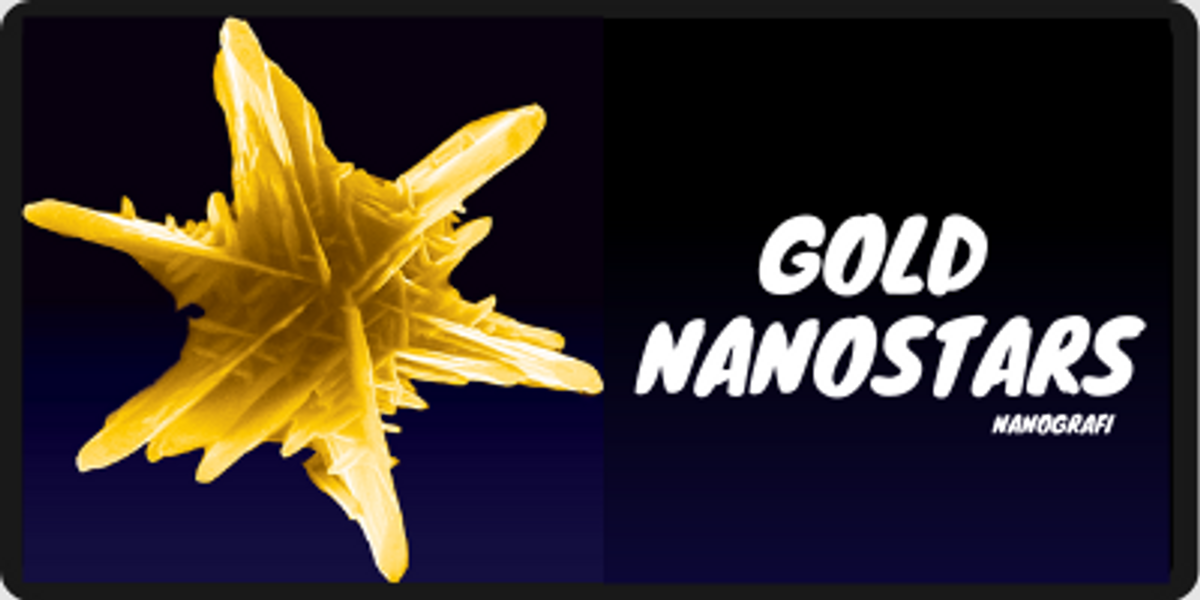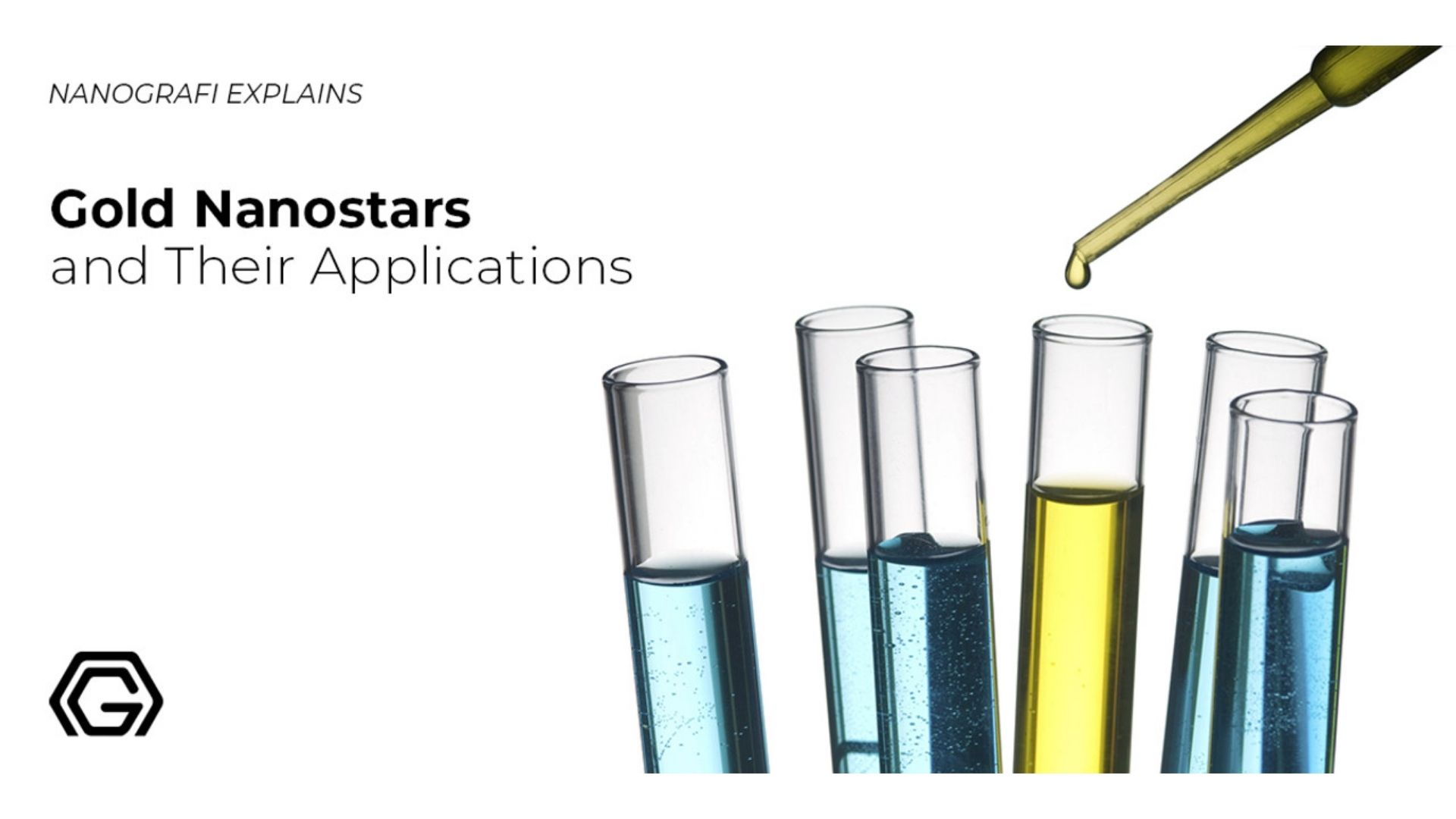Multibranched Gold Nanoparticles - Gold Nanostars
Gold nanostars, generally known to be multibranched gold nanoparticles, have emerged as a new class of nanoscale gold crystals with multiple sharp branches.
Gold nanostars possess tunable plasmon bands in near infrared (NIR) region containing star-shaped morphology serving like lightning rods responsible for enhancing the local electromagnetic field. Gold nanostars have been drawing considerable attention mainly due to the unique optical properties with applications in various areas of science, especially in biomedical applications.
Vahid Javan Kouzegaran
Analytical Chemist (Ph.D.) / Nanografi Nano Technology
Introduction
It has been shown that the multiple sharp tips and edges of nanostars are the main cause of practically high sensitivity to local dielectric alterations and significant increase in the electric fields around the nanoparticles constituting the fundamentals of detections based on localized surface plasmon resonance (LSPR) as well as surface enhancement Raman scattering (SERS) 1.
Physical Properties of Gold Nanoparticles
Gold nanostars exhibit multiple localized surface plasmon resonances corresponding to the core-tip and tips interactions depending on the applied large local electric field and the sharp ends at the tips. Surface plasmon resonance has drown physicists, chemists, biologists and material scientists attention due to its predominant applications in optical sensing, electronics, biomedicine, light generation and data storage. Technically, LSPR is associated with nanoscale noble metals creating narrow spectral absorption as well as broad scattering peaks nonlinear and linear interactions, strong near-field enhancements and electromagnetic field 1. The tremendous role of sharps spikes and tips in surface enhanced Raman scattering (SERS) spectroscopy is the motif to synthesize nanoparticles which resemble a star pattern morphologically with well-defined tips and spikes 2. As excellent SERS hot spots, the large surface area of gold nanostars facilitates surface immobilization with as much cargo including Raman reporters, moieties and other functional molecules. Gold nanostructures have turned out to exhibit two broad but distinct localized surface plasmon resonance properties like a weaker band/shoulder located at 500–600 nm and an intense band typically centered around 650–900 nm. In the case of laser irradiation at NIR region of electromagnetic wave, gold nanostars can perfectly transduce the absorbed light into heat. Such a quality makes gold nanostars serve so effectively as agents to be applied in nanomedicine. In addition, gold nanostars show potent SERS activity then those with spherical morphologies.
Synthesis and Functionalization of Gold Nanostars
The most common and widely-used method of gold nanostars synthesis is transition metals chemical reduction in salts in the presence of stabilizing agents along with the subsequent generation of metal colloids with no valance electrons in organic media or aqueous solutions. The predominant and mostly applied protocol towards the synthesis of gold nanostars however, is the aqueous reduction of gold salt using sodium citrate and the consecutive reflux process. In general, chloroauric acid (HAuCl4) is used as a reductant agent to obtain gold nanoparticles. To do so, Au3+ ions are chemically reduced to yield neutral metallic gold until the solution is supersaturated with gold nanoparticles and subsequently, gold gets precipitated gradually. Technically, the chemical reduction process of gold nanoparticles preparation involves two main steps. The first step involves the use of strong and common strong reducing agents such as borohydrides, saturated and unsaturated alcohols hydrazine, citric and oxalic acids hydroxylamine, amino boranes, sugars, polyols, hydrogen peroxide, carbon monoxide, sulfites, hydrogen, acetylene, and monoelectronic reducing agent like electron-rich transition-metal sandwich complexes. The final step includes the use of stabilizing agents such as phosphorus ligands, sulfur ligands (in particular thiolates), nitrogen-based ligands (including heterocycles), dendrimers, polymers, oxygen-based ligands surfactants and trisodium citrate dehydrate 1.
There are several significant parameters that affect the particle size and morphology of gold nanostars among which initial reagent concentrations is considered so critical. With all the reducing agents mentioned earlier, the synthesis of gold nanoparticles using HAuCl4 and citrate-stabilized agents is known to be the most common and widely adopted method to obtain gold nanoparticles. Among all the various types gold nanostructures, star-shaped gold nanostars and multibranched gold nanoparticles are interesting due to their plasmon bands quality. The synthesis of gold nanostars has been based on the environmental response of the LSPR. This is mainly associated with the sharp tips and edges of gold nanostars as the points where light can be focused.
To get more information about gold nanostars and their applications,
you can read our blog post here.
Generally, synthesis protocols of gold nanostars are classified into two main groups known as one-pot procedures and seed mediated method. In this order, numerous capping molecules include sodium dodecyl sulfate (SDS), poly diallyldimethyl ammonium chloride (PDADMAC), 2-[4-(2-hydroxyethyl)-1-piperazinyl] ethane-sulfonic acid (HEPES), cetyl-trimethyl ammonium bromide (CTAB) or chloride (CTAC), poly vinylpyrrolidone (PVP) and gelatin. Seeded-growth method using silver cations in the presence of CTAB and lithium cations in presence of PDADMAC yield gold nanostars with practically tunable morphology. In a different seed mediated method, HEPES is used as a capping agent. PVP and Ag+ have been demonstrated to serve as structure-directed reagents specifically used in gold nanostars synthesis. To do so, gold seeds are coated by PVP in ethanol and immediately added to dimethylformamide (DMF) solution which contains decent amount ofHAuCl4 and PVP. It is possible to tune the UV absorption of nanostars in the range of 725 to 850 nm following a mediated protocol. In a method, a solution containing citrate-based gold seed is used to make monodispersed gold nanostars following a two-step technique through adding silver nitrate to ascorbic acid 2. In another two-step procedure, gold nanostars are fabricated using a combination of block-copolymer micelle nanolithography deposition. Moreover, gold nanostars are prepared via incubating the samples in the aqueous solution of CTAB, ascorbic acid, silver nitrate and gold chloride hydrate 1.
Applications of Gold Nanostars
Nanoscale gold with star-shape crystals, controlled geometry and morphology has found a lot applications mainly in biomedicine, genomics, thermal therapy, clinical chemistry, biosensors, immunoassays, laser phototherapy of cancer cells and tumors and delivery platforms. Gold nanostars exhibit tunable optical behavior in NIR and visible region that leads to strong electromagnetic field enhancement at their tips. Most of gold nanostars applications are in highly sensitive platforms and probes mainly based on the LSPR exploitation and the correlated SERS signal. Particularly, SERS is considered a favorable detection method for biomolecules and biomarkers like RNA, DNA, protein and so forth basically because of its specificity, capability and sensitivity.
Conclusion
Gold nanostars are basically multibranched gold nanostructures holding the promise for novel procedures in biomedical applications such as medical diagnoses and sensing platforms. Star-shape nanoparticles have been suggested for sensing so increasingly based on their remarkable surface-enhanced Raman spectroscopy.
To get more information, you can visit Blografi.
References
1. Chirico, G., Borzenkov, M. & Pallavicini, P. Gold nanostars: Synthesis, properties and biomedical application. Gold Nanostars: Synthesis, Properties and Biomedical Application (2015). doi:10.1007/978-3-319-20768-1.
2. Liebig, F. et al. A simple one-step procedure to synthesise gold nanostars in concentrated aqueous surfactant solutions. RSC Adv. 9, 23633–23641 (2019).
Recent Posts
-
Nanocomposites in Food Packaging
The utilization of nanocomposites in food packaging represents a significant advancement in the fiel …19th Apr 2024 -
What is the Difference Between 7075 and 6061 Aluminum Alloy?
When comparing 7075 aluminum alloy to 6061 aluminum alloy, it's essential to understand their disti …5th Apr 2024 -
Iron-Air Batteries: The Ultimate Guide
Iron-air batteries represent a significant breakthrough in energy storage technology, offering a sus …29th Mar 2024







